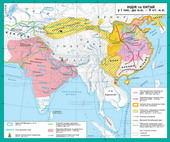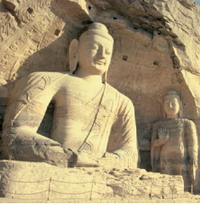§ 13.Culture of Ancient Egypt
AncientEgyptians created the amazing richness and originality of civilization. Afterdeath she was buried under sand desert perennial cap. Helped heropen the scientists who came from the French army soldiers of Napoleonend of the XVIII – at the beginning of the XIX century. Then the world learnedabout one of the oldest civilizations and its achievements in medicine, astronomy,mathematics. Names are known builders of pyramids and some artists thatadorned the walls of tombs wonderful pictures.
1. Writing
Languagesancient Egyptians in the modern world no nation does not speak, she is known asmemo written that it kept the story. Such language is called dead.The Egyptians were among the first learned to denote certain sounds and speech marks.Trademarks for letters, syllables, words and even phrases were many hundreds,they called characters. Clearlydefinite direction in writing them was not. Egyptians wrote from left to righttop to bottom or vice versa.
Kanjiadorn the walls of temples and tombs, sarcophagi pharaohs, talking about actkings and gods. Known about 1 000
such signs are most common - about 700-800. Remember allMarks was very difficult because literate people in Egypt were few. Inmainly owned and priests pystsi diploma. Ovolodivaly school diploma pystsivonly boys from the age of six. Training lasted for twelve years. For thistime they learned about 700 characters.
Egyptianswritten on various materials: clay, stone, cloth, wood. But mostpapyrus was common. Narizaly thin reed strips, then skleyuvalycrosswise, prosushuvaly and pressed. Scrolls came out huge in lengthsometimes reached several tens of meters. Papyrus was tsupkishyyfor the current paper.
Afterconquest of Egypt by the Arabs hieroglyphic writing was forgotten.
Athe first time unknown writing on the stones seen in 1799 French soldiersArmy. The text was found during work in the fortress wall outlet wonderful stonesFrench Emperor Napoleon ordered copy and send to Europe. One ofcopies fell into the hands of French scientist Jean-Fran Shampolyona.He saw that the first 14 lines of ancient Egyptian hieroglyphs were written,The following 32 lines – ancient Egyptian cursive and finally, 54lines – ancient Greek. Scientists speculated that these inscriptions are the same forcontent, but engraved with three types of writing. Then, using known himGreek language, he juxtaposed the two decoded first text box andcharacters, which marked the names of pharaohs. But this was only the first step toknowledge of the mysteries of the Egyptian writing. Other scientists continued work of J.Shampolyona. and secrets that hide their characters wereseries.
I wonder
In 196 p. BC Egyptian priestsissued a decree on perpetuate the coronation of the king PtolemyV. The text riseyou hadcarved in stone with black basalt kanjiwe demotic script(Cursive) and Greek. This stone is named Rozetskym, called Missthis,where it was found.
Terms and Notions
Kanji - Old picturesSigns of writing.
2. Scientific knowledge of the Egyptians
Math. In everyday lifeEgyptians constantly need arose to conduct calculations: measure the water level,build canals, dams and pyramids, keep a record harvest.
Forof the ancient Egyptians used the four basic arithmetic: addition, subtraction,multiplication and division. For numbers in them there were special designation. Unitsportrayed the dash, dozens – icons in the form of horseshoes, hundreds ofa twisted rope, thousands – lotus. thousands – bentfinger, hundreds of thousands - the birds, millions of – seated figure of the god. So, for example,of 50 consisted of five characters 10.
Astronomy.
The Egyptians observedthe stars and planets and learn to fix the solar and lunar eclipses.Knew planet: Venus, Mars, Mercury, Saturn, Jupiter. The Egyptians divided the starrysky of 36 constellations, created a stellar map.
Astronomicalknowledge used, projecting pyramids and temples. Based on observationsIII stars are in thousands BC Egyptians created their own solarcalendar. Over the year it had 365 days and divided into twelve parts. Eachone had 30 days. Five days that remained, adding to the endyear. They were festive. Ancient Egyptian year to start July 19,descend when the star Sirius and rozlyvavsya Nile.
Medicine.
With the development ofembalmed Egyptians have succeeded in the medical field. They carried outautopsies dead, so well known anatomy. In particular, discovered thatbody manages not heart and brain. The ancient Egyptians could treat differentdisease, and using medical tools to make complexsurgery. Along with that Egyptian medicine was closely connected withmagic. The Egyptians believed that a prayer or incantation can scaredisease.
3. Arts
Architecture.
Sinceaccording to the beliefs of the Egyptians, earthly life was just a "bridge" tootherworldly, the residential buildings were considered temporary housing. theirconstructed of brick raw umeblovuvaly only necessary. Unlikethem, "forever home" – temples and tombs – built extremelystrong. They are built of stone or vysikaly in rocks. Not accidentally gave the Egyptiansthey called "temples of millions of years."
Sinceof the Middle Kingdom, Egyptian pyramids instead of kings began to buildtemples, tombs. The most famous of them, preserved to our time, is in the cities Luxor, Karnatsi, Abydos, Abu Simbel. Over 2000years built temples in the complexKarnatsi. Alley ram-Observer Research Foundation Sphynx met devout Egyptian.Only a few yards, he fell into the great hall, surrounded by manycolumns and sculptures, which reached a height of 20 m. Temple was considered the god of housing, soit could enter the king and priests.
ByNew Kingdom pharaohs were buried in tombs, hewn in the rocks near Thebes, At a depth of about 90 m. This area was called the "Valleykings. The most famous is the tomb of Pharaoh Tutankhamun,one of the few that was not looted. Opening the tomb has enabledan idea about the material world the Egyptians: things they enjoyed,clothing. Mummy of Pharaoh was contained in one of eight sarcophagus enclosed ainto one. In a coffin Tutankhamun a wreath of fieldflowers. Were unique temples that followed the dynasty Ptolemaic: Temple Isis on o.File, Temple Mount in Edfu.
Sculpture.
Ancient Egyptianstatues made of various stones. Less frequently used for thiswood, copper, gold and silver. The statues have different sizes – ofvery small to giant. Often rozfarbovuvaly sculptures to conveyskin color, clothing and jewelry. There were certain immutable rules for creating shapes.
SculpturePharaoh has always distinguished the large size and solemn posture, knees drawn up tohand, Bill Beard, symbols of imperial power. The priests, officials, pystsiv,artisans, peasants portrayed very realistically.
InSculptures of ancient Egypt had religious significance, put them near the temples,put in tombs and pyramids. They are marked by an individual, and therefore theyvykarbovuvaly character's name. An example of the magnificent sculptures have fourgiant (21 m)sitting sculpture RamsesII and six standingSculpture (10 m)Pharaoh and his wife in Abu Simbel.
Widespreadsculptural image of a sphinx – creature with the head of human or animal body andlion. The Egyptians considered it a sacred creature.
MaybeSphinx guarding the dead kings, citing fear of mere mortals. Near Pyramidsin Giza alone in a grand froze hewn from the rock face with King Sphinx Hefrena. Striking its size. At length he reaches 73 m in height – 20 м.
Painting.
SkillArtists Ancient Egypt affects not only the wealth of themes and images but alsotechniques and only their inherent compositional techniques increation of artistic images.
Carefulviewers will notice that the Egyptians portrayed the figures of people depending on theirposition in society. Thus, the figure of Pharaoh was always larger than the others.Persons people, the manners of the Egyptians depicted facing the viewer, head andfeet – in profile. Extremely realistic points in ancient EgyptianArtists animals. On the walls of tombs and temples see agriculturalanimals, birds and fish. Back in the ancient kingdom of the Egyptians loved to depict scenesof rural life. In the tomb walls were always filled with images of gods,scenes that showed life in hereafter.
We do notknow the names of most artists leave their many creations on the wallstombs, temples and palaces. Scientists believe that an entire wall drawings executedteam of artisans with clearly defined responsibilities. Initially the work was set to"One who expresses the form of": he is following the rules, drew the contours of the futurepicture. Next artisan intensified paths, creating a relief.
Afterof the other artists under the direction of "brigadier" wooden or reedBrushes painted image plane. Over the range of them served as a stonetablet on which they bred paint with crushed stone or othernatural material: with malachite green dye obtained with ocher – redand brown, with coal – black.
Music. Already in the days of Ancientkingdom existed percussion, string and wind instruments. Oldestwere wooden percussion instrument "rattle", which reflect the time. Laterthere were drums of different shapes and sizes. Traditional instrument wasARF, which took the form of a bow. its made of wood. Ultra-luxurydecorated harp, intended for the palace of Pharaoh. Harp decorated with gold leaf,painting, engraving and symbolic figures.
Interestingknow
In ancient Egypt men and women used the Spacearithmetic. By numberpaint face could EIDnachytysocial status Egyptian. Eye shadow, blush, lipstick, Arotematic ointments and liquids rich Egyptianskept in the heatthelial vessels, madearm's length from the skilled craftsmen gold orprecious cargomenu. Such vessels zazvytea, presented on New Year 19 July.
Interestingknow
In 1922, Englishman Howard Carter found coveredentrance to the tomb. Only one of the halls of the tomb Tutankhamun3500 archaeologists found various valuable items. Total weight of gold -600 kg.Among them Mask Tutankhamun made of gold. Itsweight reached 10 kg.Now it is kept in the Cairo Museum (Egypt).
FAQtask
1. Because why not read hieroglyphics?
2. As the Egyptians in writing the number marked?
3. What rules exist in painting and sculpture Egyptians?
4. Name the greatest temples of Ancient Egypt.
5. What kind of art Egyptians have achieved youropinion, the greatest success? Give your opinion.
Generalization forForms
The Egyptians built the system of irrigation facilities, pryborkavshy Neil, thanksWhat country was the breadbasket of the Ancient East. Left the world and majestic pyramidstemples.
We have created maps of the sky and the solar calendar, in which year was365 days and divided by 12 months to 30 days each.It is similar to the calendar we use.
Who achieve outstanding success in the medical field. Mastered the artmummification.
 English
English

























